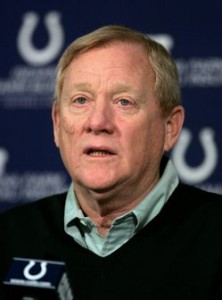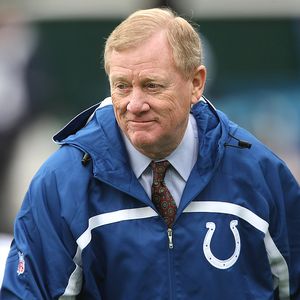Now that I have established my position on the Jim Caldwell issue, it’s time to look at what the Colts should address this coming offseason.
Obviously, the personnel decisions begin with quarterback Peyton Manning, whose $98 million contract is due to expire. Colts owner Jim Irsay has repeatedly expressed his desire to make Manning a Colt for life and the league’s highest-paid player.
That ultimately will happen.
By Drew Allen
Let’s please dismiss two recurring arguments among heated Colts fans and gossipers:
- No, Manning will not take a hometown discount in his new deal. Sure, the idea of the four-time MVP agreeing to sign for a tad less money so that the organization can invest in other areas on the roster sounds all well and good, but don’t overlook the influence of the market and the players’ union. The bargaining point for Manning was set in early September when New England quarterback Tom Brady signed his mega-contract. If Manning were to take significantly less than market value, you had better believe the players’ union will take issue and step in somehow.
- No, Manning is not leaving Indianapolis via free agency, a la LeBron James. Some fans have wondered if such a decision (no pun intended) were a possibility with Manning’s contract expiring, but it’s not. If Manning and the Colts don’t come to an agreement as free agency approaches (whenever that might be), the team will place the franchise tag on its starting quarterback of 13 seasons. That will only buy Indy more time to negotiate with Manning and ensure that he stays for the remainder of his career.
Long story short, Manning’s deal will get done. The uncertainty surrounding the new collective bargaining agreement could slow negotiations, but we should expect to see a five- or six-year deal that pays Manning an average of $20 million per year.
What else needs to happen in Indy?
Here are more items that should top Irsay’s and President Bill Polian’s offseason agendas:
- Establish the coaching staff. The news that the Colts had decided to fire Gene Huey, who had served as the team’s running backs coach for 16 seasons, came as a shock to many fans, and plenty of them were quick to label the dismissal as scapegoating for Polian’s inability to assemble a strong offensive line — the real problem behind Indy’s lackluster running game. While there’s some truth to that notion, Huey might or might not have had to do with the disappointing lack of progress made by second-year back Donald Brown, a first-round draft pick in 2009 who fell to third on the depth chart behind Joseph Addai and 31-year-old Dominic Rhodes, whom the team signed in December for a (brief) third stint in Indy. The Colts need to hire a replacement who can teach the same techniques Huey taught, namely pass-blocking. The team also needs to monitor the statuses of senior offensive assistant Tom Moore and linebackers coach Mike Murphy, who both consider themselves year-to-year when mulling retirement.
- Make a decision at strong safety. The loss of Bob Sanders to injury in 2010 was predictable, but the Colts probably didn’t expect to lose backup Melvin Bullitt as well. Bullitt, a former undrafted free agent, had filled in effectively when Sanders had gone down in the past, and Indy rewarded his efforts last offseason by tendering him at the second-round level. The move made perfect sense at the time because the team also tendered free safety Antoine Bethea and Sanders’ 2010 salary wasn’t dreadful at about $2.2 million; it allowed the Colts to keep all their safeties for another year. That’s not the case now. While Bethea is signed long-term, Bullitt is again due to become a free agent, and Sanders’ base salary is scheduled to jump to $5 million. The team must either a) bank on Sanders staying healthy and allow Bullitt to walk or b) address Sanders’ contract — it can be restructured or Indy can release Sanders — and re-sign Bullitt. Given that Sanders has missed 64 of 112 career games, the latter option seems more likely.
- Revamp the offensive line. We’ve been here before, haven’t we? While I can’t really fault the offensive line as much as in the past — the running game excelled late in the regular season, and Addai found sufficient holes in the wild-card loss to the New York Jets — the Colts still aren’t talented enough up front. Seemingly every position could use an upgrade. Charlie Johnson’s effort at left tackle has been admirable, but he’s not the athletic player the team would prefer to have protecting Manning’s blind side and would be ideal inside at guard. Right tackle Ryan Diem commits far too many penalties. The guard rotation can’t seem to bully opposing defensive fronts, and center Jeff Saturday appears to be nearing the end of his career. Indy also lacks desirable depth along its offensive line. This is sure to be a point of emphasis in April’s NFL draft as Polian admitted to erring last year in passing on tackle Rodger Saffold, who immediately became St. Louis’ starter at left tackle. I wouldn’t rule out the spending of some free-agent dollars on a few more guards, either.
- Hit on draft picks. While Polian has had a Hall of Fame-worthy career as an executive, his most recent drafts have not lived up to the standards he has established for himself. True, he still has made some brilliant selections, including Pierre Garcon in the sixth round in 2008, Austin Collie in the fourth round 2009 and Pat Angerer in the second round last year, but the majority of his latest draft choices — notably high picks — haven’t panned out to this point. As previously mentioned, Donald Brown couldn’t beat out 31-year-old Dominic Rhodes, and 2010 first-rounder Jerry Hughes barely played at all this season as a rookie. Granted, it’s too early to judge those two, but the Colts simply can’t afford a lack of production from early-round picks when they perennially draft at the bottom of round one. This year’s draft should be encouraging in that Indy will have its highest first selection since 2002 in the No. 22 pick. The key is to draft the best player on the board regardless of position, no matter how badly the Colts might need offensive linemen. An example: extremely unrealistic, I know, but if A.J. Green is there at No. 22, Indy should take him as opposed to Anthony Castonzo or Gabe Carimi, whom several mock drafts have the Colts selecting.

